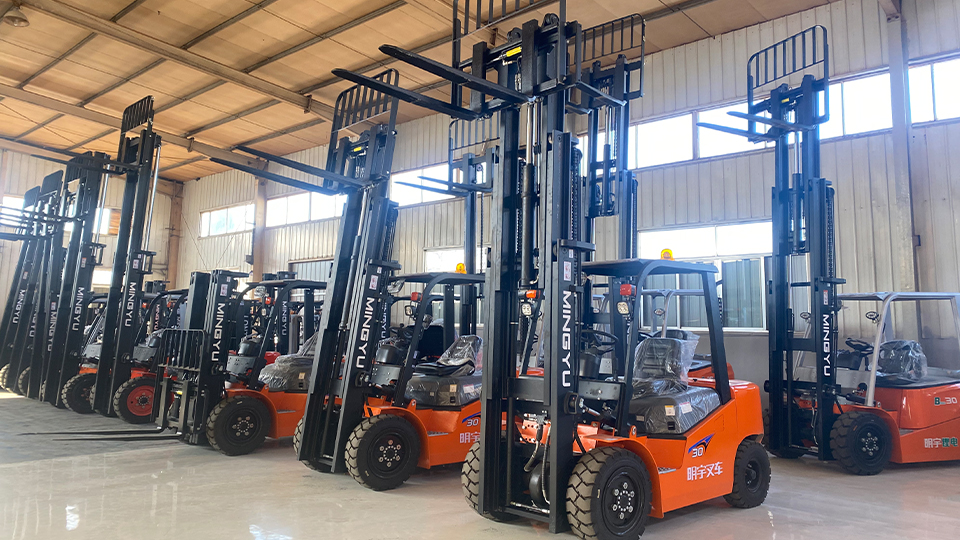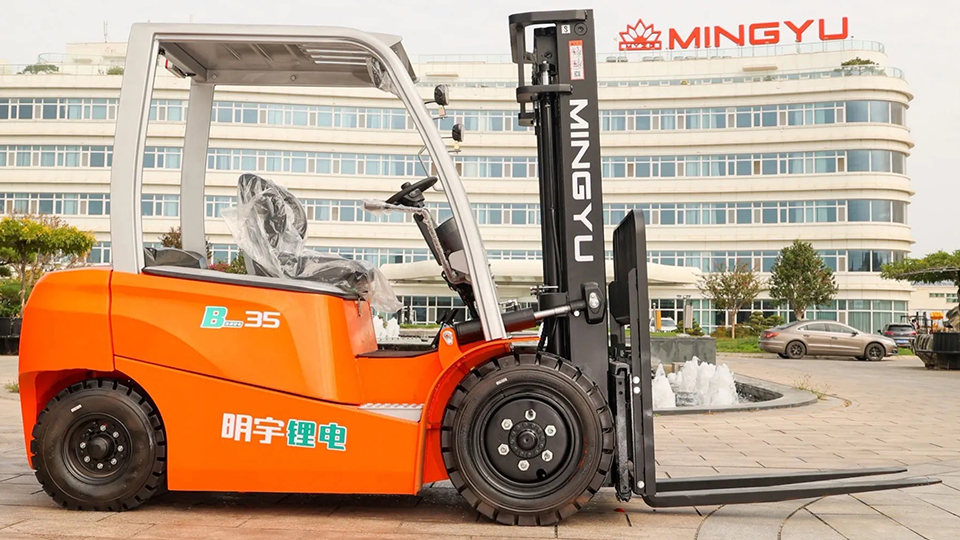
The Critical Dimension: Deconstructing the Question "How Wide Is a Forklift?"
The question, "How wide is a forklift?" is beautifully deceptive in its simplicity. It suggests a single, universal number, but in the highly specialized world of material handling, a forklift's width is one of its most critical, non-standardized dimensions. It is the defining feature that determines a machine's utility, its stability, and the fundamental layout of the facility in which it operates.
There is no "average" forklift width that applies across the board. Instead, the width of a Powered Industrial Truck (PIT)—the official term for a forklift—is a direct, function-driven result of its regulatory class, intended load capacity, and operational environment. Widths can range from a mere 2.5 feet (30 inches) for certain pallet jacks up to 8.5 feet (100+ inches) for heavy-duty, rough-terrain models.
This article will perform a technical decomposition of forklift width, examining the engineering drivers, the class-specific dimensions, and the crucial relationship between truck width and mandatory aisle spacing.
Part I: The Fundamental Engineering Drivers of Width
Before diving into the classes, it is essential to understand the core technical forces that govern a forklift’s width. The ultimate trade-off in forklift design is always between Stability and Maneuverability.
1. The Stability Triangle and Counterbalance
The most prevalent design, the counterbalance forklift (Classes I, IV, and V), relies on the principle of the Stability Triangle. The machine’s width is integral to this concept.
Lateral Stability: The wider the axle stance (or overall width), the greater the machine's resistance to tipping sideways, especially when turning with a high or heavy load. A narrow forklift would dramatically increase the risk of a lateral tip-over, violating fundamental safety engineering principles.

Counterweight Integration: For electric counterbalance trucks (Class I), the heavy battery pack acts as the counterweight. The physical size of this battery package often establishes the minimum width of the chassis. For Internal Combustion (ICE) trucks (Classes IV and V), the engine block and fuel tank are positioned to achieve counterbalancing mass, similarly dictating a wide, stable frame.
2. Tire Type and Ground Clearance
The type of tires required for the operating environment directly influences the overall width.
Cushion Tires (Indoor/Class I, IV): These are solid rubber, requiring no air, and are small in diameter. Since they are used on smooth, flat indoor floors, they allow for a narrower overall chassis and lower ground clearance, enhancing maneuverability and stability on predictable surfaces.
Pneumatic Tires (Outdoor/Class V, VII): These are air-filled, treaded tires (often foam-filled for puncture resistance) that are significantly larger in both diameter and width. They are necessary to provide traction, shock absorption, and flotation on uneven ground (gravel, dirt, etc.). The sheer physical size of these tires forces the machine to have a much wider axle and overall chassis dimension.
3. Load Handling and Capacity
The maximum safe lifting capacity is directly correlated with width.
High Capacity, High Width: A forklift designed to lift $20,000 \text{ lbs}$ requires a chassis that is substantially wider than one designed for $3,000 \text{ lbs}$. This width is necessary to spread the tremendous forces across the floor and to provide the foundational stability needed to prevent the center of gravity from shifting outside the stability triangle under load. Large-capacity Class IV and V trucks can easily exceed $7 \text{ feet}$ in width.
Part II: Forklift Width by Regulatory Class (ITA/OSHA)
The seven classes of Powered Industrial Trucks are fundamentally defined by their approach to width, often resulting in entirely different operating philosophies.
Class I: Electric Motor Rider Trucks (Standard Electric Counterbalance)
Typical Width Range: $40 \text{ to } 45 \text{ inches}$ (approx. $3.3 \text{ to } 3.75 \text{ feet}$)
Technical Rationale: The width is the result of balancing counterbalance weight (the battery) with the need for tight maneuverability in indoor settings. They are designed to be compact enough to enter and exit trailers and operate in conventional warehouse aisles, which are typically $12 \text{ to } 13 \text{ feet}$ wide.
Class II: Electric Motor Narrow Aisle Trucks (Reach, Order Pickers, Turret Trucks)
Typical Width Range: 1$36 \text{ to } 42 \text{ inches}$ (approx.2 $3 \text{ to } 3.5 \text{ feet}$)
Technical Rationale: This class prioritizes extreme narrowness over a massive counterweight. Instead of width, they achieve stability through outriggers (Reach Trucks) or by operating exclusively in confined Very Narrow Aisle (VNA) systems where the load is often constrained by the racking itself (Turret Trucks). Their very function is to maximize storage density by operating in aisles as narrow as $5 \text{ to } 8 \text{ feet}$. They are the specialists of the tight squeeze.
Class III: Electric Motor Hand Trucks (Pallet Jacks, Walkie Stackers)
Typical Width Range: $25 \text{ to } 30 \text{ inches}$ (approx. $2 \text{ to } 2.5 \text{ feet}$)

Technical Rationale: These are the smallest and narrowest class. Because they only lift a few inches off the ground (low-lift) or have limited lift height (stackers), they do not require a massive counterbalance. The width is just enough to safely accommodate a standard pallet ($40 \text{ inches}$ wide) between their straddle legs or chassis while allowing the operator to walk alongside or ride on a narrow platform.
Class IV: ICE Trucks (Cushion Tires)
Typical Width Range: 3$65 \text{ to } 70 \text{ inches}$ (approx.4 $5.4 \text{ to } 5.8 \text{ feet}$)
Technical Rationale: As sit-down counterbalance machines using combustion engines, they are naturally wider than their electric counterparts (Class I) due to the necessity of housing the engine, transmission, and cooling systems. The need for high-capacity lifting further increases the required width for stability, though the use of smooth cushion tires keeps the overall profile manageable for large indoor or dock operations.
Class V: ICE Trucks (Pneumatic Tires)
Typical Width Range: 5$70 \text{ to } 100 \text{ inches}$ (approx.6 $5.8 \text{ to } 8.3 \text{ feet}$)
Technical Rationale: This class sees the largest range in width due to its high versatility. The primary driver of this width is the large pneumatic tires themselves. To handle rough outdoor terrain, the tires and the axle must be significantly wider than a cushion-tire truck. A $5,000 \text{ lb}$ capacity pneumatic truck might be on the lower end, while a heavy-duty, outdoor $36,000 \text{ lb}$ unit can easily be over $8 \text{ feet}$ wide.
Class VI & VII: Tractors and Rough Terrain Trucks
Class VI (Tuggers): 7$30 \text{ to } 40 \text{ inches}$. Since they pull and do not lift loads with forks, their width only needs to accommodate the chassis, engine/battery, and operator cab.8 They prioritize a compact footprint for maneuvering articulated loads.
Class VII (Rough Terrain): 9$85 \text{ to } 90 \text{ inches}$ (approx.10 $7 \text{ to } 7.5 \text{ feet}$ and often wider). These machines, especially telehandlers (variable reach), are designed with wide, reinforced chassis and massive axles. The great width is necessary to maintain stability when lifting loads high and forward on highly irregular or sloped surfaces.
Part III: The Technical Relationship: Forklift Width vs. Aisle Width
The width of a forklift is ultimately meaningless until it is placed into a work environment. The machine's physical width is the initial component of the Minimum Required Aisle Width—a critical dimension for safety and facility efficiency.
OSHA does not specify a single minimum aisle width, but safety standards mandate that aisles must be wide enough to accommodate the safe passage of the largest equipment used.11 Industry engineers rely on a specific calculation to determine this.
The Minimum Aisle Width Formula
The aisle width must be large enough to allow the forklift to turn $90$ degrees and stack a load (known as right-angle stacking) without colliding with the racking. The formula is:
$$\text{Minimum Aisle Width} = \text{Right Angle Stacking Width} + \text{Load Length} + \text{Safety Clearance}$$
1. Right Angle Stacking Width ($\text{RASW}$):
This is the technical specification provided by the manufacturer. It represents the smallest space the forklift needs to execute a 12$90$-degree turn and fully insert the forks.13
The $\text{RASW}$ is directly related to the forklift's overall width and its turning radius. A narrower forklift with a tighter turning radius (like a 3-wheel Class I) will have a smaller $\text{RASW}$.
2. Load Length ($\text{LL}$):
This is the longest dimension of the load being carried, typically the length of the pallet (e.g., 14$48 \text{ inches}$ for a standard GMA pallet).15
3. Safety Clearance ($\text{SC}$):
Industry standard typically calls for a 16$12 \text{ inch}$ minimum clearance (17$6 \text{ inches}$ on each side) to account for operator error, load sway, and to prevent accidental contact with the racking.18 Some facilities mandate more.
Case Study: Standard Counterbalance (Class I/IV)
Assume a standard $5,000 \text{ lb}$ Class IV forklift with a $\text{RASW}$ of $94 \text{ inches}$.
Load Length: 19$48 \text{ inches}$.20
Safety Clearance: 21$12 \text{ inches}$.22
$\text{Minimum Aisle Width} = 94'' + 48'' + 12'' = 154 \text{ inches } (12.83 \text{ feet})$
This calculation explains why conventional warehouses are built with Wide Aisles of 23$12 \text{ to } 13 \text{ feet}$.24
Case Study: Narrow Aisle Truck (Class II)
Assume a Class II Narrow Aisle Reach Truck with a $\text{RASW}$ of $46 \text{ inches}$.
Load Length: 25$48 \text{ inches}$.26
Safety Clearance: 27$12 \text{ inches}$.28
$\text{Minimum Aisle Width} = 46'' + 48'' + 12'' = 106 \text{ inches } (8.83 \text{ feet})$
This demonstrates how the specialized, narrow design of a Class II truck allows a warehouse to reduce its aisles to the $8 \text{ to } 10 \text{ foot}$ range (Narrow Aisles), thereby adding significant storage capacity.
Conclusion: The Width as a Strategic Variable
To return to the initial question, "How wide is a forklift?"—the answer is "As wide as it absolutely has to be to safely perform its intended task, and no wider."
The width of a powered industrial truck is not arbitrary. It is a calculated variable that represents a critical, inherent trade-off in machine design:
Maximum Width (e.g., Class V, Class VII) ensures superior lateral stability and the necessary footprint for large tires and heavy loads, at the cost of vast aisle space.
Minimum Width (e.g., Class II, Class III) ensures maximum storage density and maneuverability in tight quarters, achieved by sacrificing the traditional counterbalance design for specialized, outrigger-based stability.
For operators, understanding their machine's width is the difference between safe navigation and catastrophic collision. For facility managers, a millimeter of width can translate into miles of shelving and millions of dollars in storage capacity. The technical dimension of forklift width is therefore a cornerstone of industrial efficiency and safety.
Name: selena
Mobile:+86-13176910558
Tel:+86-0535-2090977
Whatsapp:8613181602336
Email:vip@mingyuforklift.com
Add:Xiaqiu Town, Laizhou, Yantai City, Shandong Province, China